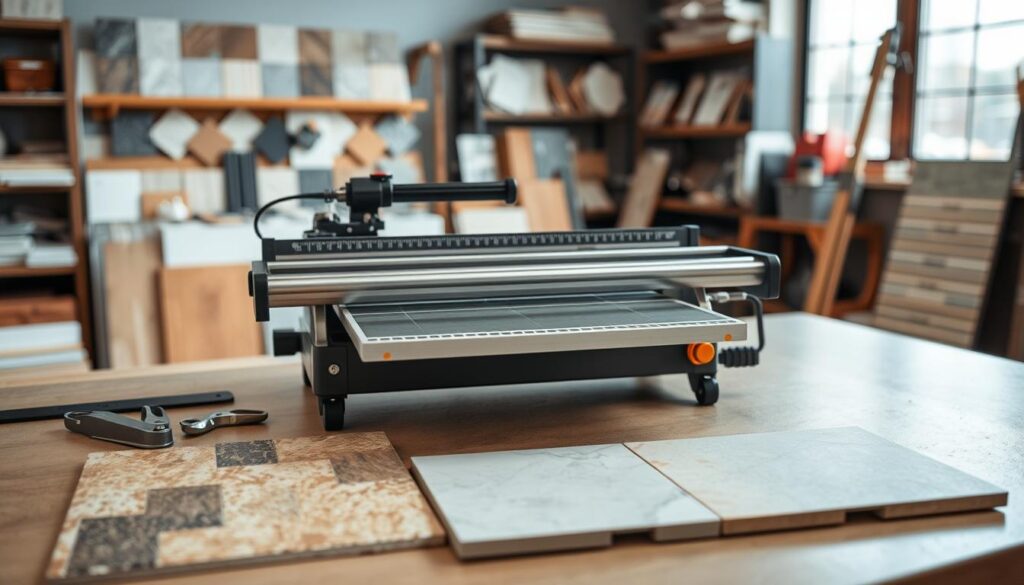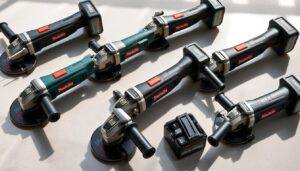Are you struggling to achieve precise cuts with your current tile cutting tool?
Manual tile cutters are a popular choice among DIY enthusiasts, with their rectangular shape and scoring wheel allowing for accurate cuts. By placing the tile on the bed of the cutter and using the handle to score it, you can achieve a clean break.
Investing in a quality cutter is essential for achieving professional-looking results in your tiling projects. With various options available, including manual and electric cutters, it’s crucial to choose the right tool for your specific needs.
Key Takeaways
- Discover the most effective tile cutters for home DIY enthusiasts.
- Learn why investing in a quality tile cutter is crucial for professional-looking results.
- Explore both manual and electric options, highlighting their strengths and limitations.
- Understand the key features to look for when selecting a cutter for your needs.
- Get expert recommendations based on extensive testing and professional experience.
Understanding Tile Cutters: Your Key to Professional Results
To achieve a flawless finish in your tiling project, understanding the role of tile cutters is crucial. A good tile cutter can literally make or break a tiling project. Without the ability to neatly cut tiles to a desired length, your dreams of laying tile yourself will end with an embarrassed call to your local tiler asking for help.
Why a Quality Tile Cutter Makes All the Difference
A quality tile cutter serves as the foundation for any successful tiling project, making the difference between professional results and costly mistakes. Manual tile cutters work through a scoring and snapping mechanism that creates clean, straight edges when used correctly. This precision is essential for achieving a professional finish.
- Manual tile cutters are generally preferred for straight cuts and ceramic tiles.
- Electric tile cutters excel with harder materials and intricate cutting patterns.
- The right choice depends on your specific project requirements, including tile material, thickness, and the complexity of cuts needed.
Manual vs. Electric Tile Cutters: Key Differences
Understanding the differences between manual and electric tile cutters is vital for selecting the right tool for your project. Manual tile cutters are ideal for straight cuts in ceramic tiles, offering a cost-effective and straightforward solution. On the other hand, electric tile cutters use water-cooled diamond blades to cut through tiles, offering precision for complex cuts and tougher materials.
The key differences between manual and electric options include portability, power requirements, precision capabilities, and suitable applications for each. Professionals often have both types in their toolkit, using each for their respective strengths.
Types of Tile Cutters for Home DIY Projects
Tile cutters are essential tools for any DIY tiling project, and knowing the differences between manual and electric cutters is vital. When it comes to home DIY projects, the type of tile cutter you choose can significantly impact the outcome.
Manual Tile Cutters: Precision Without Power
Manual tile cutters are ideal for straight cuts and are generally more convenient to use. They are perfect for beginners and straightforward tiling projects. The mechanical components of manual tile cutters, including scoring wheels and breaking mechanisms, allow for precise cuts without the need for power.
These cutters are suitable for projects where the tile needs to be cut in a straight line, such as in bathroom renovations or kitchen installations. Manual tile cutters are also more portable and require less storage space compared to electric cutters.
Electric Tile Cutters: Power and Versatility
Electric tile cutters, on the other hand, offer advanced capabilities, including the ability to make complex cuts and handle thicker materials. They are particularly useful for projects involving natural stone or where intricate cuts are required.
An electric tile cutter operates similarly to a table saw, with a diamond blade cutting the tile while a guide keeps it straight. The wet cutting system used in electric models helps prevent damage to both the blade and the tile by keeping them cool during the cutting process.
Electric tile cutters are best suited for larger projects or for those who anticipate needing to make a variety of cuts. While they require more skill to use and take more time to set up, the versatility they offer can be invaluable for complex tiling projects.
What to Consider When Choosing a Tile Cutter
Selecting the right tile cutter for your home improvement project involves considering several key factors. The type of tile, the size of your project, and your budget are crucial elements that will guide your decision-making process.
Tile Material and Thickness
The material and thickness of your tiles significantly impact your choice of tile cutter. For instance, ceramic tiles are generally easier to cut than porcelain tiles, while natural stone requires specialized equipment. Thicker tiles also necessitate more powerful cutting tools to ensure clean cuts and prevent damage.
| Tile Material | Recommended Cutter | Thickness Limit |
|---|---|---|
| Ceramic | Manual Tile Cutter | Up to 10mm |
| Porcelain | Electric Tile Cutter | Up to 15mm |
| Natural Stone | Specialized Stone Cutter | Varies |
Project Size and Complexity
The scope and complexity of your project are also vital considerations. Larger projects may justify investing in higher-quality tile cutters to save time and improve accuracy. If your project involves intricate cuts or a variety of tile materials, you may need a more versatile cutting solution.
Budget Considerations
Your budget plays a significant role in choosing the right tile cutter. While it’s tempting to opt for the cheapest option, investing in a quality tool can provide long-term value by reducing wastage and improving results. Consider not just the initial cost but also the cost of any tiles you might waste due to poor cutting.
Essential Features of Quality Tile Cutters
Understanding the critical features of a quality tile cutter is vital for making an informed purchase decision. When you’re working on a project, the right tile cutter can make all the difference in achieving professional results.
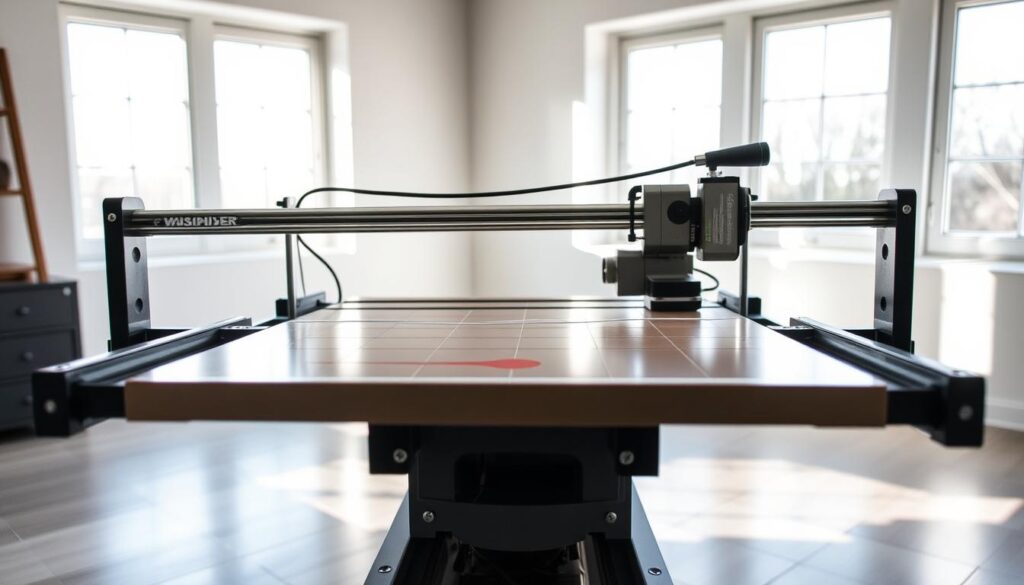
Cutting Capacity and Blade Quality
The cutting capacity of a tile cutter is determined by the size of its blade. A larger blade can handle thicker tiles, which is particularly important when working with robust materials like porcelain or stone. It’s essential to choose a tile cutter with a high-quality, durable blade to ensure clean and precise cuts without damaging the tiles. Consider the material composition, sharpness retention, and replacement options when evaluating blade quality.
Build Quality and Stability
A well-constructed tile cutter made from high-grade materials can withstand regular use, providing longevity and reliability. Look for models with a solid base and non-slip rubber pads or feet, which help stabilise the cutter during operation. The build quality and frame construction significantly affect the stability during cutting and the long-term durability of the tile cutter.
Top Tile Cutters for Home Use: Professional Recommendations
The quest for the perfect tile cutter for home use is a common one, and we’re here to help you navigate it. With numerous options available, it’s essential to understand what makes a tile cutter suitable for home DIY projects.
What Makes a Tile Cutter Suitable for Home Use
A tile cutter suitable for home use should possess certain key characteristics. “Ease of use, versatility, and value for money are crucial factors that DIY enthusiasts should consider when selecting a tile cutter,” says an industry expert. You’ll want a tool that is not only effective but also easy to operate, even for those without extensive experience.
Our Testing Methodology
Our rigorous testing methodology assesses cutting precision, ease of operation, durability, and overall performance. We tested each model with various tile materials and thicknesses to ensure our recommendations are applicable to diverse home projects. Our scoring system weighs factors like build quality, cutting capacity, precision, and price-to-performance ratio.
As we tested products across different price points, you can trust that our recommendations are unbiased and focused on finding the best options regardless of budget.
Best Professional-Grade Manual Tile Cutters
To tackle challenging tile cutting jobs with confidence, consider investing in a high-quality manual tile cutter. Professional-grade manual tile cutters are designed to deliver precise cuts and durability, making them ideal for demanding home projects.
Montolit Masterpiuma Evolution3 29″ Push Porcelain Tile Cutter
The Montolit Masterpiuma Evolution3 29″ Manual Tile Cutter is renowned for its exceptional build quality and precision scoring system, making it a favourite among professionals. It excels at cutting porcelain tiles from 8 to 12mm thick, creating straight cuts with ease thanks to its inbuilt lubrication system.
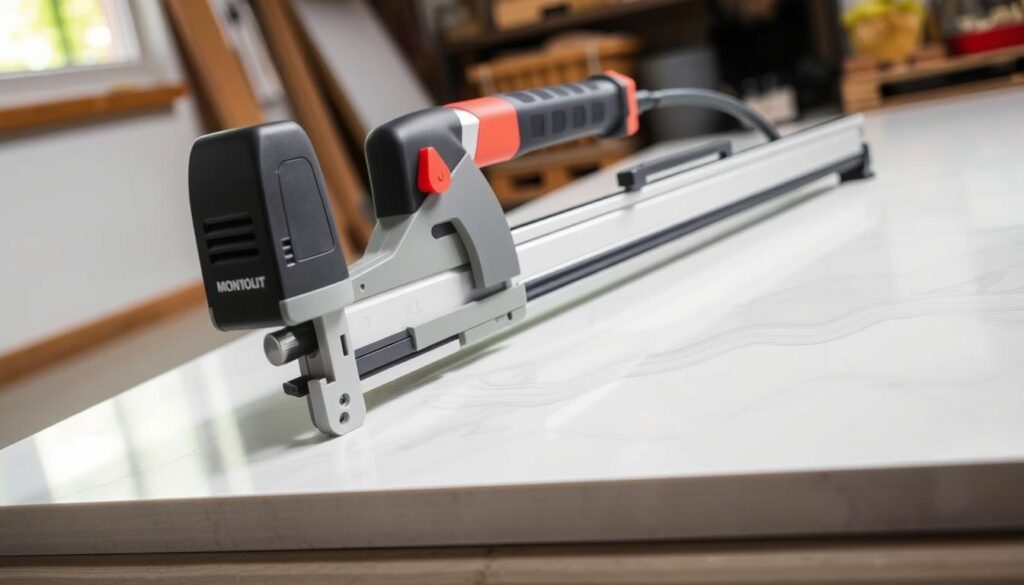
Rubi Speed-N Tile Cutter
The Rubi Speed-N Tile Cutter strikes a balance between professional features and accessibility, making it a popular choice among serious DIY enthusiasts. Although it lacks some of the more advanced features of its professional counterparts, it retains the quality and design characteristics that Rubi Tools is known for.
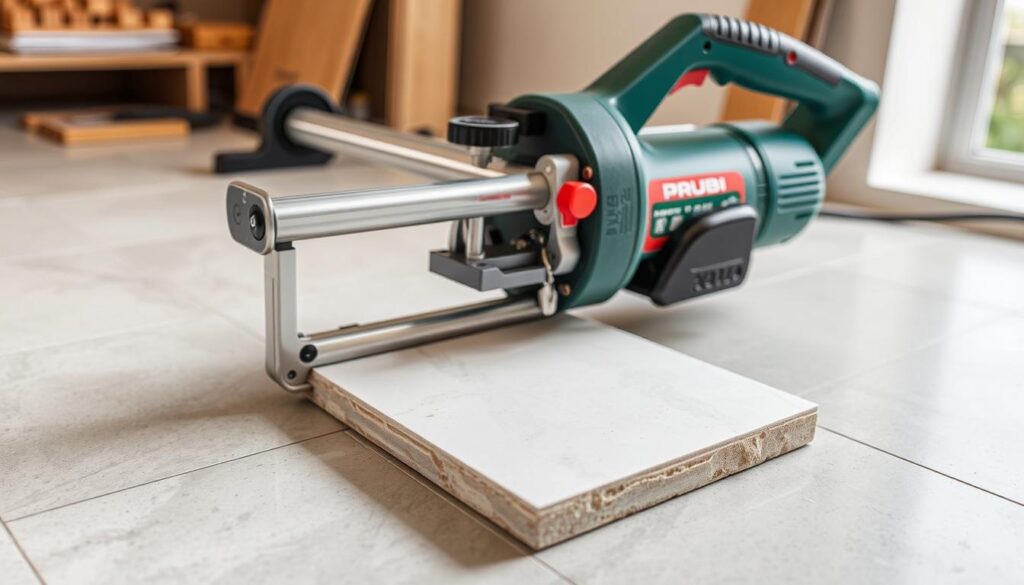
Sigma Pull Handle 26″ Tile Cutter 3B4
The Sigma Pull Handle 26″ Tile Cutter is another top-tier manual tile cutter capable of handling tiles up to 24″ and smaller. Its rotatable measuring bar allows for diagonal cuts up to 18.5″, providing versatility for various projects.

These three manual tile cutters represent the gold standard in their category, offering features that justify their higher price points. By comparing their maximum cutting capacities, breaking mechanisms, and special features, you can determine which one best suits your specific needs.
Best Mid-Range Manual Tile Cutters
Mid-range manual tile cutters are a popular choice among homeowners due to their versatility and cost-effectiveness. These cutters offer a balance between performance and affordability, making them suitable for various home DIY projects.
Tomecanic 29″ Supercut 2175 Tile Cutter
The Tomecanic 29″ Supercut 2175 Tile Cutter is a robust tool designed for cutting large tiles. It can score and cut 24″ porcelain tiles with some finesse, although seeing the scoring line can be challenging due to its massive breaker bar.
Key Features: Robust construction, capable of cutting large porcelain tiles.
Limitations: Not ideal for precision cuts or cutting mosaics.
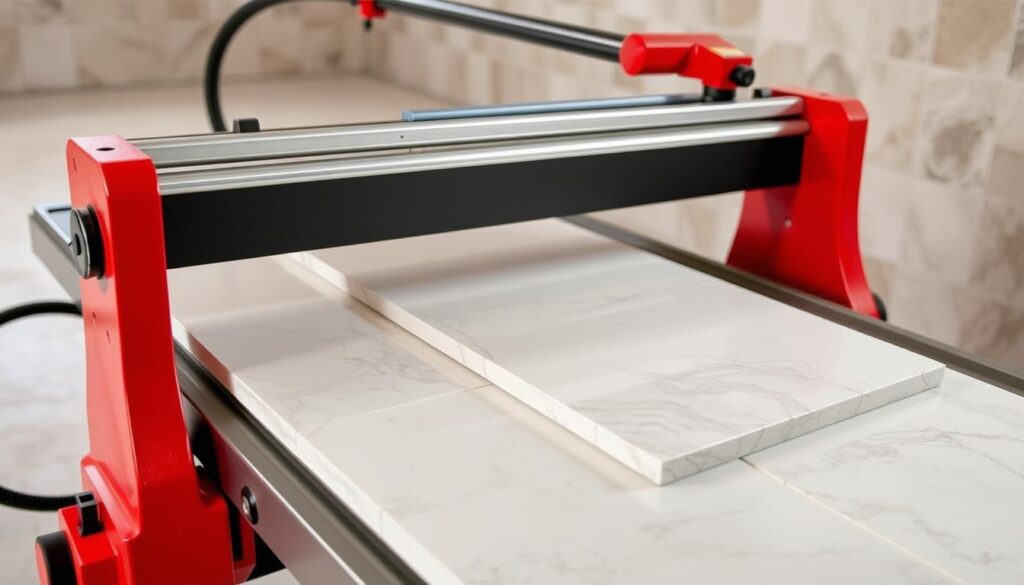
QEP 10630Q 24-Inch Manual Tile Cutter
The QEP 10630Q 24-Inch Manual Tile Cutter is an extremely affordable option, widely available in the market. While it’s a bargain basement buy, the performance can be inconsistent, especially with harder porcelain tiles.
Key Features: Budget-friendly, widely available.
Considerations: Performance can be hit-or-miss, particularly with porcelain tiles.
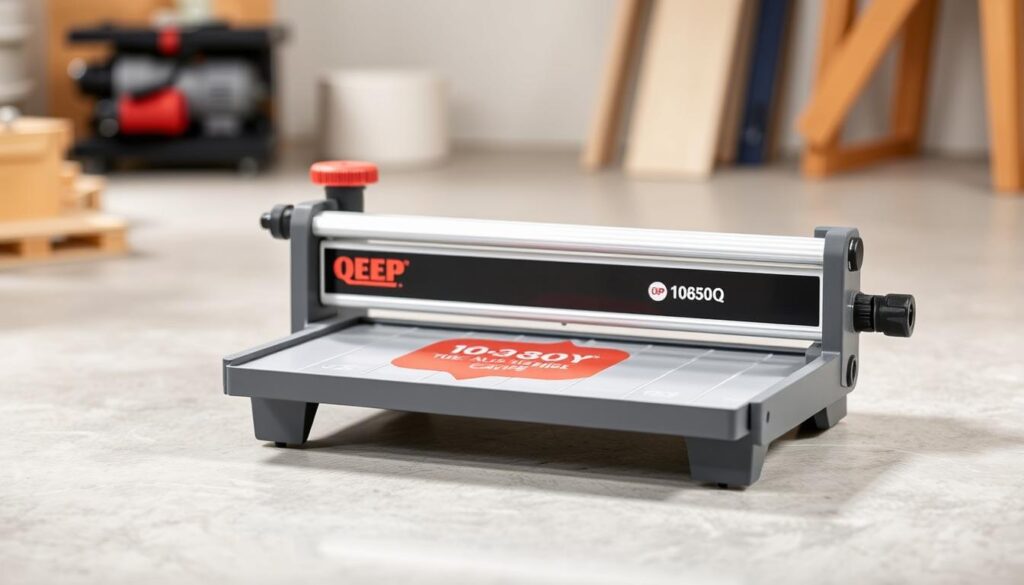
When choosing a mid-range manual tile cutter, it’s essential to consider the specific needs of your project. Both the Tomecanic 29″ Supercut 2175 and the QEP 10630Q 24-Inch Manual Tile Cutter have their strengths and weaknesses. By understanding these factors, you can make an informed decision that meets your requirements.
Budget-Friendly Tile Cutters for Occasional Use
Occasional DIY projects don’t have to break the bank, thanks to budget-friendly tile cutters. If you’re looking to install a backsplash or work on a small tiling project, you don’t necessarily need to invest in a high-end tile cutter. In this section, we’ll explore two budget-friendly options that can help you achieve your DIY goals without overspending.
QEP10900Q35-Inch Manual Tile Cutter
The QEP10900Q35-Inch Manual Tile Cutter is a robust option for those who need to cut larger tiles. With its 35-inch cutting capacity, it’s suitable for a variety of tiling projects. This manual tile cutter features twin chrome-plated rails and a curved handle, making it easier to score and cut tiles accurately.
While it’s designed for cutting ceramic and porcelain tiles, its effectiveness on harder materials may be limited. Nonetheless, for standard ceramic tiles, it’s a reliable choice. You can find more information on tile cutters and their applications on Bob Vila’s website.
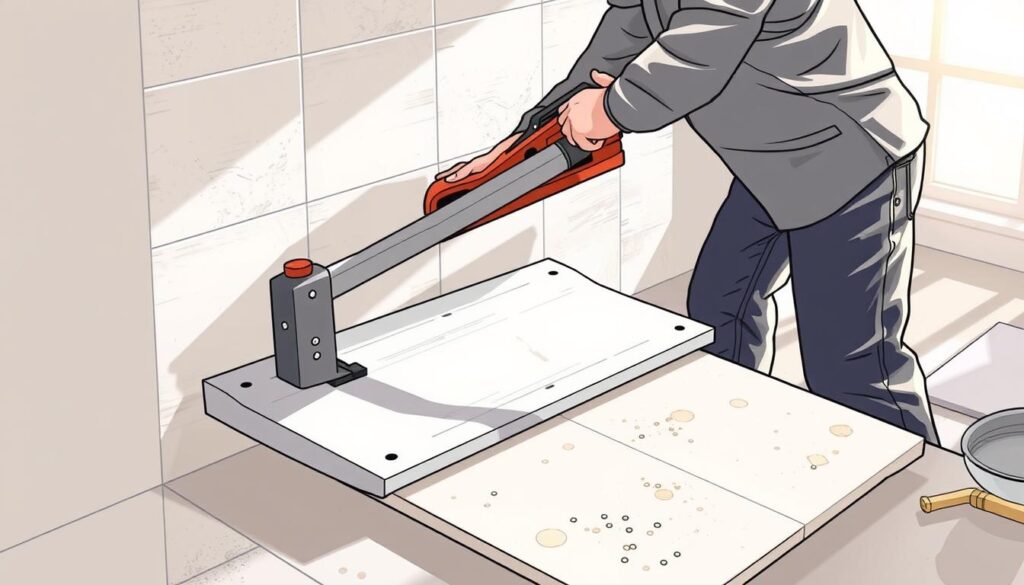
QEP10214Q14″ Rip Ceramic Tile Cutter
For smaller projects, such as installing a kitchen backsplash with subway tiles, the QEP10214Q14″ Rip Ceramic Tile Cutter is an ideal choice. This compact tool is designed specifically for cutting ceramic tiles and is available at an affordable price point, typically under $50.
While it may not be as durable as more expensive models, it gets the job done for small, occasional projects. Its compact size and ease of use make it a great option for DIY enthusiasts who don’t want to invest in a professional-grade tile cutter.
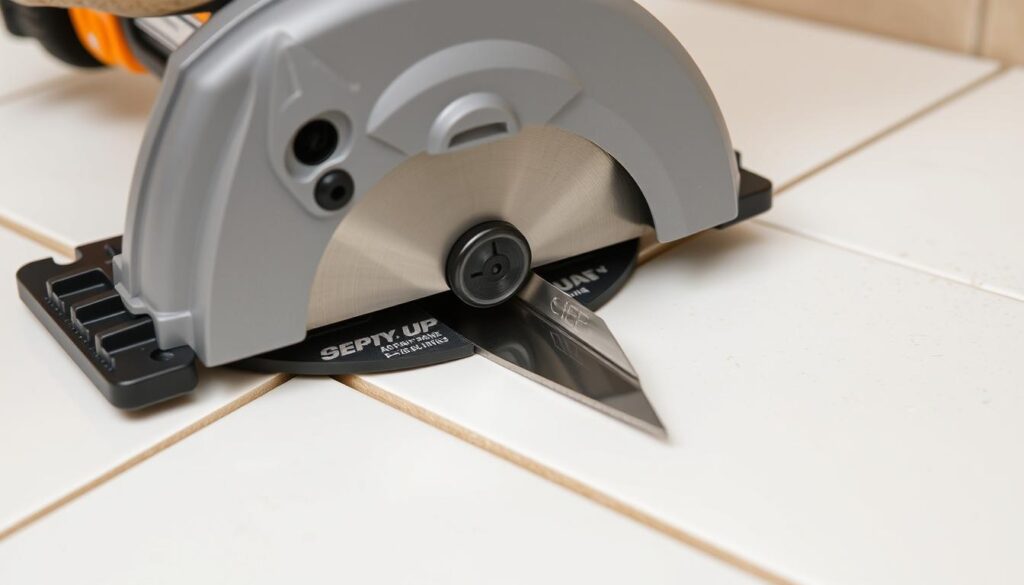
Best Electric Tile Cutters for Home Projects
Precision and power are crucial for demanding tiling projects, making electric tile cutters a top choice. These tools offer the versatility and accuracy needed for a wide range of tile materials, especially thicker or larger format tiles.
Electric tile cutters utilise water-cooled diamond blades, similar to wet saws, to cut through various types of tiles efficiently. This method not only reduces dust but also prolongs the life of the blade. When choosing an electric tile cutter, it’s essential to consider the type of tiles you’ll be working with and the specific features of the cutter.
Rubi BL-ND-180 Smart Electric Tile Cutter
The Rubi BL-ND-180 Smart Electric Tile Cutter is a professional-grade tool equipped with a 180mm diamond blade. It’s designed to cut through porcelain, ceramic, and stone tiles with ease, using a water-cooled system to maintain optimal blade temperature and reduce dust.
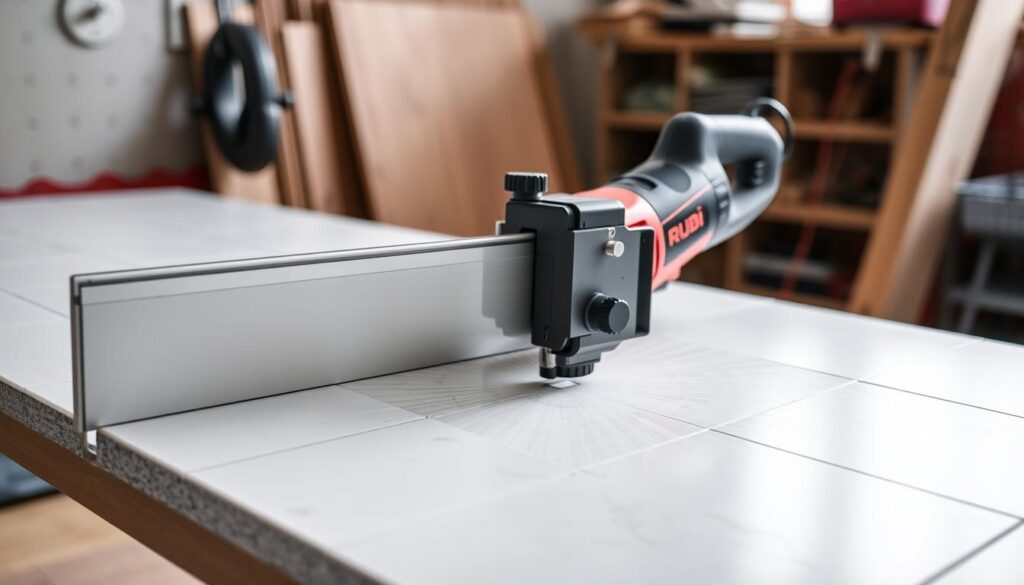
This model features a tip-up table for making mitre cuts, enhancing its versatility for various tiling projects. The Rubi BL-ND-180 is ideal for both professionals and serious DIY enthusiasts who require high-quality cutting performance.
Siri Briccolina Electric Tile Cutter
The Siri Briccolina Electric Tile Cutter is a versatile and efficient tool suitable for cutting ceramic tiles, porcelain, marble, and granite. Available in both 110V and 230V versions, it’s designed to meet the needs of both professional tilers and DIY enthusiasts.
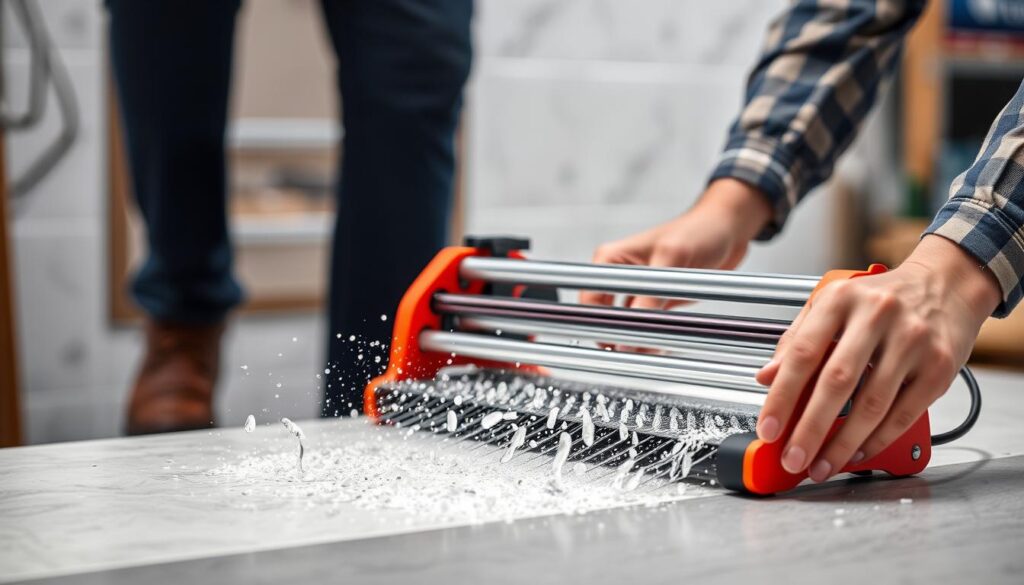
This portable wet saw features a unique design with its motor immersed in cooling water, ensuring optimal temperature management and extended tool life. The Siri Briccolina Electric Tile Cutter is perfect for projects that require precision and reliability.
Both the Rubi BL-ND-180 and Siri Briccolina Electric Tile Cutters offer significant advantages for cutting harder materials that manual cutters might struggle with. Understanding the setup requirements, including water management and workspace needs, is crucial for achieving professional results with these powerful tools.
Matching Tile Cutters to Specific Materials
To get professional results, you need to match your tile cutter to the specific tile material. Different materials have unique properties that require tailored cutting tools to achieve the best results.
Best Cutters for Ceramic and Porcelain Tiles
Ceramic tiles are generally easier to cut than porcelain tiles due to their less dense composition. For ceramic tiles, a manual tile cutter with a good quality scoring wheel is often sufficient. However, porcelain tiles are denser and harder, requiring higher-quality scoring wheels and stronger breaking mechanisms. For both types, manual tile cutters are suitable, but for thicker or harder porcelain tiles, an electric tile cutter may be necessary.

Cutting Natural Stone and Glass Tiles
Natural stone tiles have a veined structure that makes them challenging to cut with traditional score-and-snap tile cutters. An electric tile cutter, commonly referred to as a tile saw, equipped with a diamond blade is the best tool for cutting natural stone. For glass tiles, specialized cutters or blades designed to prevent chipping are essential. Using the right cutter for these materials ensures clean cuts and minimizes waste.
By understanding the properties of your tile material and selecting the appropriate tile cutter, you can achieve professional results and make your project more efficient.
Maintenance Tips to Extend Your Tile Cutter’s Lifespan
Proper care and maintenance can significantly extend the lifespan of your tile cutter. To ensure your tool continues to perform optimally, regular cleaning is essential. Remove tile dust and debris from the rails and moving parts to maintain smooth operation.
For manual tile cutters, proper lubrication is crucial. Apply oil to the necessary components as recommended by the manufacturer. For electric tile cutters, maintenance includes checking the water pump, inspecting the blade, and protecting the motor.
| Maintenance Task | Manual Tile Cutters | Electric Tile Cutters |
|---|---|---|
| Regular Cleaning | Yes | Yes |
| Lubrication | Yes | No |
| Blade Inspection | No | Yes |
Regularly inspect your tile cutter for signs of wear on critical components like scoring wheels and diamond blades. Store your tool in a dry, dust-free area to prevent damage. By following these maintenance tips, you can extend the time between replacements and ensure your tile cutter remains in good working condition for future use.
Conclusion: Investing in the Right Tile Cutter for Your Needs
A good tile cutter is more than just a tool; it’s a key to unlocking professional-grade tiling results at home. By considering factors like material compatibility and cutting capacity, you can make an informed decision. This ensures precision cuts and a professional finish for your tile projects.
Investing in the right tile cutter transforms a daunting task into an achievable DIY project, adding value to your toolkit for future use.
